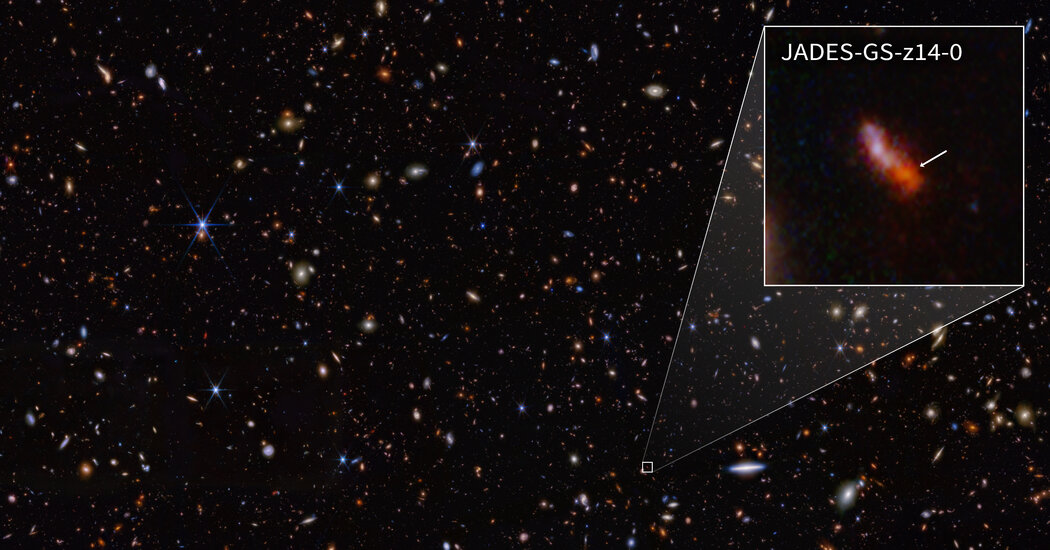Since the James Webb Space Telescope began operating two years ago, astronomers have been using it to leapfrog one another millions of years into the past, back toward the moment they call cosmic dawn, when the first stars and galaxies were formed.
Last month, an international team doing research as the JWST Advanced Deep Extragalactic Survey, or JADES, said it had identified the earliest, most distant galaxy yet found — a banana-shaped blob of color measuring 1,600 light-years across. It was already shining with intense starlight when the universe was in its relative infancy, at only 290 million years old, the astronomers said.
The new galaxy, known as JADES-GS-z14-0, is one of a string of Webb discoveries, including early galaxies and black holes, that challenge conventional models of how the first stars and galaxies formed.
“This discovery proves that luminous galaxies were already in place 300 million years after the Big Bang and are more common than what was expected,” the researchers wrote in a paper posted to an online physics archive.
“Galaxy formation models will need to address the existence of such large and luminous galaxies so early in cosmic history,” said the authors, who were led by Stefano Carniani, a professor at the university Scuola Normale Superiore in Pisa, Italy.
The galaxy was first spotted during a deep space survey with the Webb’s Near Infrared Camera, one of the telescope’s workhorse instruments. Within a patch of southern sky known as the Jades Origin Field, which is about a quarter of the size of a full moon, scientists found 11 galaxies that seemed to date from when the universe was less than 400 million years old — far more than they had expected.
Subsequent studies by Dr. Carniani and his colleagues with the telescope’s infrared spectrograph revealed that the wavelength of light from JADES-GS-z14-0 had been stretched more than 15-fold by the expansion of the universe (a redshift of 14 to use astronomical jargon), similar to the way a siren’s pitch becomes lower as it speeds away. That means light has been coming toward us for 13.5 billion years, since shortly after the universe began. (The universe is about 13.8 billion years old, according to cosmological calculations.)
The light from the galaxy is spread over a diffuse region, which indicates that the glow was coming from stars, not the gullet of a black hole. Its brightness corresponded to the output of hundreds of millions of suns, an astonishing number to have formed and assembled in only 290 million years.
The starlight also contained spectral signatures of oxygen, which did not exist when the universe was first born. That means the stars in that galaxy had already undergone several of the cycles of birth, death, and rebirth, which have enriched the universe with the heavy elements we need to evolve and exist.
How that happened in such a short time is a mystery, one riddle in a sky full of them. Some astronomers have suggested that supermassive black holes — formed from the collapse of primordial gas clouds — could have served as the seeds for galaxies.
In a blog post, Dr. Carniani and Kevin Hainline of the University of Arizona, another member of the JADES team, wrote: “It is likely that astronomers will find many such luminous galaxies, possibly at even earlier times, over the next decade with Webb. We’re thrilled to see the extraordinary diversity of galaxies that existed at Cosmic Dawn!”
